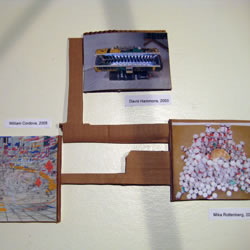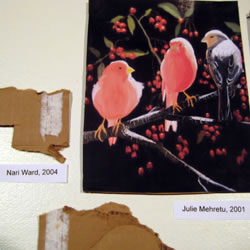Case Study
With or Without You: Art in Harlem, 2000 - 2006 (April 23 - August 15, 2010)
Sanford Biggers, Ann Craven, Ellen Gallagher, Deborah Grant, Nicolas Guagnini, David Hammons, Dave McKenzie, Julie Mehretu, Wangechi Mutu, Senam Okudzeto, Paul Pfeiffer, Michael Queenland, Jessica Rankin, Marc Andre Robinson, Nadine Robinson, Karin Schneider, Dana Schutz, Nari Ward, and others

In early 2005 Triple Candie began research on a survey exhibition of art made in Harlem since 2000. "Made in Harlem: 2000 - 2006" was to celebrate the high level of work being created in a neighborhood with extraordinary artists but without art spaces or any cohesive artist community. The exhibition proved impossible to realize.
Artists at the time -- particularly those from groups who had been historically marginalized, such as recent graduates or artists of African descent -- were in great demand. The market was booming, and these artists had commitments on their work before it was even made. Galleries, anxious to have product for art fairs and biennials, discouraged artists from participating in projects that didn't have commercial benefit. Artists, swept up in the frenzy and wanting to capitalize on the moment, eagerly agreed. This left small, but ambitious, non-profit spaces like Triple Candie unable to get access to high-quality work.
In organizing the original show, we approached artists we knew for loans. We asked Ellen Gallagher for a painting; she offered us an older print. When we approached Dana Schutz, her gallery maintained that there was no work available. David Hammons' collector AC Hudgins refused to lend any work because Hammons himself wouldn't authorize it. Julie Mehretu and Paul Pfeiffer, whose studios were next door to the gallery, didn't return phone calls.
When it became clear that we would not get access to museum-quality work, we cancelled the show. Five years later, we offered up this substitute, not out of spite but to highlight how our notion of "community" and that of these artists fell in and out of synch based on changing priorities and opportunities. It included reproductions of the artists' work -- works that might have been included in the original show -- but we shuffled the attributions. Harlem residencts who visited were mis-educated about the work of artists living and working in their community.



